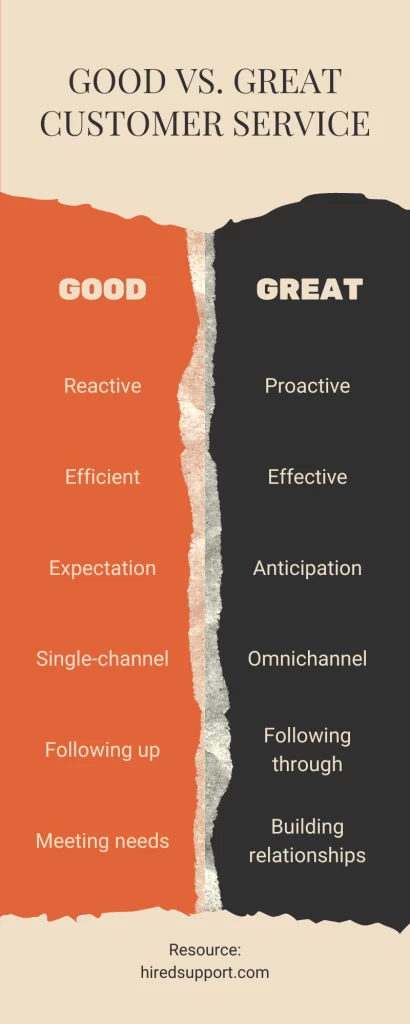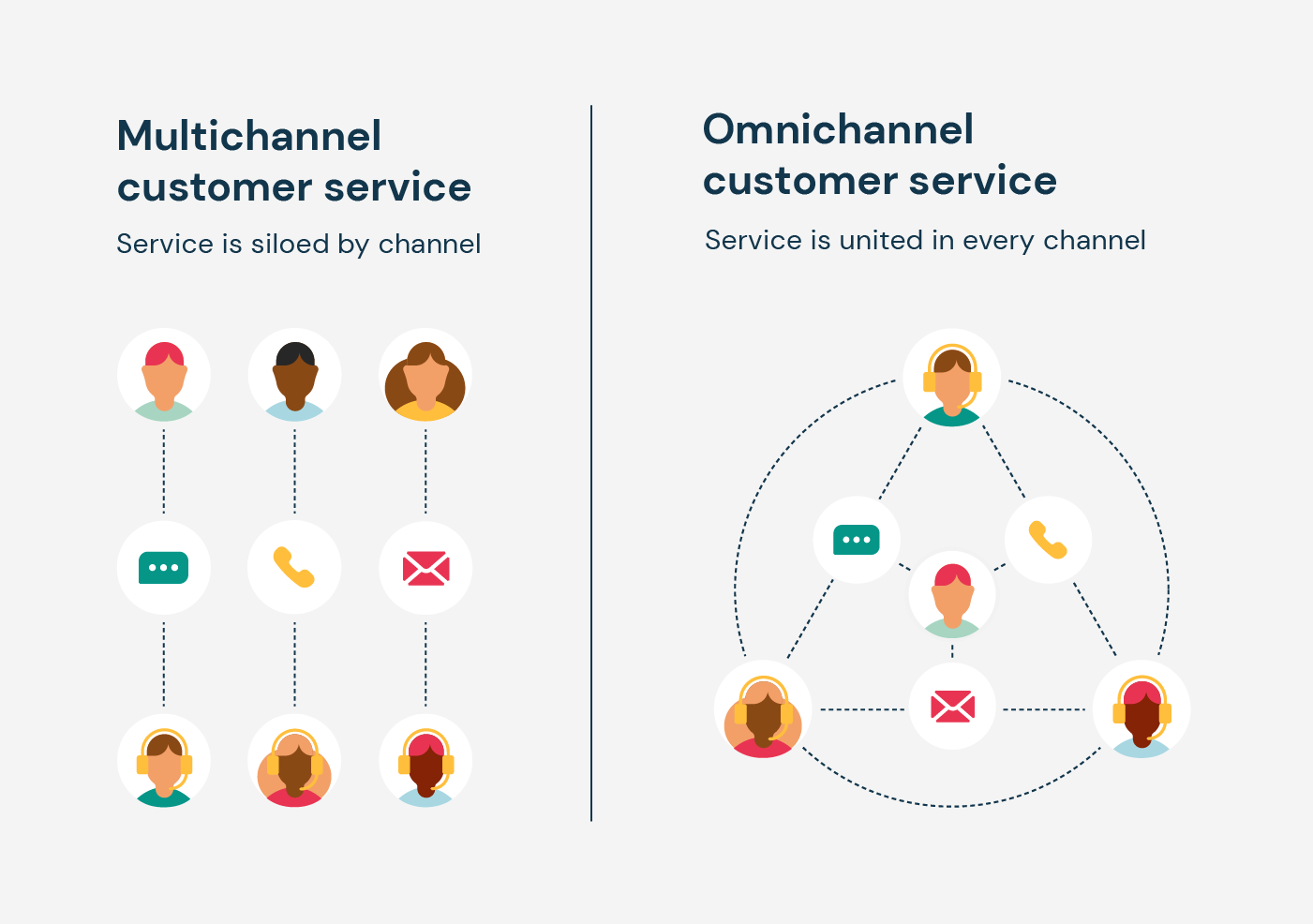Did you know that any organization can boost its revenue by 10-15% simply by enhancing its customer experience (CX)? Just as there’s a difference between living up to expectations and exceeding them, there’s a difference between good and great customer service. From using CRM systems to creating a positive customer service culture, there are many ways to improve your customer support. In this blog post, we’ll learn how to upgrade your CS from good to great through ten ways.
Table of Contents
The levels of customer service can be divided into three layers – musts, satisfiers, and delights.
Naturally, the musts are essential for the proper operations of the customer service department of every business.
These include having a reasonable price, fixing the customer’s problem, and having good business hours.
Then come the satisfiers, these can be placed under the tab of good customer service.
Satisfiers are those elements that satisfy a customer, such as having quality customer support, the proficiency of support agents, and a minimum resolution time.
Then there are the delights, which can be classified as elements of great customer service.
These elements of great customer service, aka the delights, include going out of the way to make your customer feel great by remembering their purchase history, sending them thank you emails, and giving promotions.
What is Customer Experience
Customer experience is the overall feeling of a customer after they have interacted multiple times with a company, both directly as well as indirectly.
It is not limited to the user interface or the ease of navigation but also depends heavily on the kind of customer service that your company provides.
Furthermore, the increase in competition in recent times has forced businesses to upgrade their customer service.
The competition has risen so much that studies by Microsoft revealed 81% of businesses primarily compete based on customer service.
That means doing the bare minimum won’t be enough – you have to put in more effort to enhance your customer service from good to great.
Difference Between Good and Great Customer Service
While providing great customer service is a game of efforts, putting in efforts vaguely can lead to a waste of resources.
That’s why, knowing where to spend your resources, and where to put in the effort is necessary.
Good customer service is hearing customer complaints, looking for a solution, resolving their complaints, and then repeating the process.
Great customer service is listening to what the customer says, knowing the solution beforehand, resolving the complaint on first contact, and not letting the issue repeat itself.
Similarly, good customer service is answering customer queries and guiding the customer throughout the process.
Great customer service, however, is providing such a seamless process that customer queries are kept to a minimum.
Consider Amazon’s example – you hardly need to contact their support. They’ve already established such a smooth process that you don’t feel like contacting them for minor problems.
Bonus tip: Ensure that you have the correct customer service metrics in place such as Customer Satisfaction (CSAT) score and Net Promoter Score (NPS).
Recommended: 15 Proven Practices to Improve CSAT in 2023
Following are the ten key differences between good and great customer service:
Expectation vs. Anticipation
One of the key differences between good and great customer service lies in the concept of expectation versus anticipation.
Good customer service effectively meets customers’ expectations.
Customers’ needs are addressed in a professional manner, providing solutions to problems and satisfying queries.
This type of service adequately covers the requirements, delivering precisely what customers ask for.
However, great customer service takes this a step further. It not only meets but anticipates customers’ needs.
This is where the differences between good and great customer service become significant. Representatives in a great customer service scenario foresee potential issues, offering proactive solutions.
They might present solutions to problems that customers didn’t realize existed or provide advice on optimizing their product or service usage.
This level of service surpasses merely fulfilling expectations, leaving customers feeling valued and pleasantly surprised.
Reactive vs. Proactive
The differences between good and great customer service are further underscored when we compare a reactive approach versus a proactive one.
In good customer service, the approach tends to be reactive.
The representatives respond when customers encounter problems or have queries. They address the issue presented to them and ensure it’s resolved.
On the flip side, great customer service is proactive.
This is an important difference – great service representatives often predict potential complications before they arise.
They proactively work to resolve these, even before the customer is aware of them.
This proactive approach minimizes potential disruptions for customers and shows them that the company is genuinely committed to providing the best possible service.
Satisfaction vs. Delight
Another crucial difference between good and great customer service revolves around customer satisfaction and customer delight.
Good customer service is often about achieving customer satisfaction. This means resolving customer issues promptly and ensuring their needs are met.
When customer queries are answered effectively, it often results in satisfied customers.
Great customer service, however, goes beyond merely satisfying customers to delighting them.
A distinguishing feature between good and great customer service is that the latter aims for customer delight, creating memorable experiences.
It can involve adding personal touches, exceeding expectations, or making the extra effort to impress customers.
This is where customer service becomes an art, turning ordinary interactions into extraordinary experiences, leaving customers delighted and loyal to the brand.
Standard Procedures vs. Personalized Experience
Good customer service often relies on standardized procedures to provide consistent service.
This approach ensures that every customer gets an acceptable level of service, with all their concerns appropriately addressed.
However, great customer service knows that every customer is unique and values a personalized experience.
These customer service representatives tailor their approach to suit each customer’s specific needs and preferences, providing personalized solutions rather than generic ones.
This level of personalization is a standout feature in the differences between good and great customer service, and it’s a practice that makes customers feel genuinely cared for, fostering stronger relationships and higher customer loyalty.
Competent Service vs. Expert Knowledge
Competency is a critical factor in customer service.
A good customer service representative is competent, understands their product or service well, and can help customers with most issues.
They can navigate through standard situations and address the customer’s needs adequately.
On the other hand, great customer service involves representatives with expert knowledge. They have an in-depth understanding of their product or service and the industry they are in.
This expertise allows them to provide customers with comprehensive support, advice, and insights that a competent representative might not be able to.
In the differences between good and great customer service, the level of expertise and knowledge can significantly impact the quality of service provided.
Efficient vs. Effective
Efficiency is a characteristic of good customer service.
Representatives respond to queries and solve problems quickly, focusing on minimizing the time spent on each customer interaction.
They adhere to scripts and protocols to expedite processes and ensure customer needs are addressed promptly.
In contrast, the difference between good and great customer service becomes apparent when we consider effectiveness.
Great customer service emphasizes effectiveness over mere efficiency.
While quick responses are appreciated, great customer service takes time to thoroughly understand customer issues, provides comprehensive solutions, and ensures the customer is completely satisfied.
This depth in service might take more time but leads to better outcomes and more satisfied customers.
Single-channel vs. Multichannel Support
Good customer service often offers support via a single, traditional channel – be it phone, email, or in-person support.
This ensures that customers can reach out to the company and have their needs addressed via that one channel.
However, a clear difference between good and great customer service is the use of multichannel support in the latter.
Great customer service recognizes that customers have varying preferences for communication, and they cater to these by offering multichannel support, such as phone, email, live chat, social media, and even chatbots.
If you want to go even further, you should connect all the multiple channels of communication and have an omnichannel presence.
Omnichannel support means that all your communication channels are interconnected.
For example, a customer might initiate a conversation through live chat. However, their issue might be complicated and require additional support through email or call.
Ensure that such a level of support is available and that a customer can transition from one channel to another seamlessly, without having to repeat their issue everytime they switch a channel.
This variety of channels makes it easier for customers to contact the company in a way that suits them best, leading to an improved customer experience.
Conflict Resolution vs. Conflict Prevention
Conflict resolution is a critical component of good customer service.
When customers have complaints or issues, the service team steps in to resolve these conflicts.
They work to smooth things over and ensure the customer is satisfied in the end.
However, one major difference between good and great customer service lies in conflict prevention. Instead of just resolving issues, great customer service aims to prevent conflicts before they occur.
They do this by maintaining excellent product quality, providing clear and comprehensive product information, and proactively addressing potential problem areas.
This approach minimizes the possibility of customer dissatisfaction and shows customers that their peace of mind is a top priority.
Meeting Needs vs. Building Relationships
Good customer service focuses on meeting the immediate needs of customers.
The team provides answers, solves problems, and ensures customers have what they need at the moment.
This kind of service leaves customers feeling cared for and their needs met.
The difference between good and great customer service, though, is evident when we look at relationship building.
Great customer service goes beyond just meeting immediate needs – it focuses on building long-term relationships with customers.
Representatives make an effort to understand customers on a deeper level, remembering past interactions, and personalizing their service.
This relationship-focused approach leads to a deeper connection with customers, enhancing loyalty and advocacy.
Following up vs. Following Through
In good customer service, following up is crucial.
After a problem is resolved or a question is answered, representatives check in to ensure that the customer is satisfied.
This follow-up demonstrates care and commitment to the customer’s well-being.
Great customer service, however, emphasizes following through.
It ensures that commitments made to customers are honored, actions promised are completed, and long-term solutions are implemented.
Following through not only resolves immediate problems but also builds trust and shows customers that the company respects and values them.
These key differences between good and great customer service highlight the importance of not just meeting customer needs but going above and beyond to create outstanding customer experiences.
Great Customer Service Case Study
Munheeb Rasheed, a customer service representative (CSR) at HiredSupport, suggests,
“the correct identification of a customer’s problem should be the utmost priority of a CSR. We’ve observed numerous times that agents tend to send canned responses without understanding what the customer is really asking for in the first place.”
Identification of a customer query is the first step toward providing an enhanced level of customer service.
While canned responses (preset responses or macros) help respond rapidly to the customer, they can, at times, sound robotic and might lack empathy.
For example, suppose you have an e-commerce firm. A customer orders a product from your website and pays through a credit card.
However, more than enough days pass by and he contacts your live chat support. He isn’t pleased with the service and straight away asks for a refund.
What should customer service do when they encounter such a difficult customer?
According to Nouman Prince, a live chat agent at HiredSupport, “Be empathetic and understand the customer’s situation“.
Being kind and human to a customer will resolve more than half of your problem.
Then, tell the customer what seems to be the bottleneck and address the issue at hand once they’ve calmed down.
Whether the issue’s on your end or that of the shipping authorities involved, be completely transparent with them.
If they stress about the refund, immediately inform them of the conditions for the refund and the process for it.
This would be good customer service.
However, if you want to take your customer service up a notch, offer them a token of compensation in the form of a discount on their purchase.
Provide them with a discount voucher if they would like to place an order again with you.
That way, you can make sure that your customer doesn’t leave you.
Customer experience statistics reveal that 13% of consumers who have had a negative CX would share it with about 15 people.
So you need to make sure that a negative customer experience is kept to a minimum!
Conclusion
In a nutshell, the difference between good and great customer service lies not just in the process of delivering service but also in its philosophy.
Good customer service typically meets expectations, resolves issues, and ensures customer needs are addressed.
It is efficient, competent, and predominantly reactive in its approach. While this form of service is indeed beneficial, it primarily serves to maintain a baseline of customer satisfaction.
However, as we have explored, great customer service transcends these basics.
It anticipates needs, delights customers and forges a deeper connection with them. The aim here is to offer a personalized, expert, and effective service that leverages multiple channels for communication.
The approach is proactive, seeking to prevent issues rather than just resolving them.
The most significant difference between good and great customer service, though, is that the latter focuses on building long-lasting relationships with customers.
This involves following through on commitments, exceeding expectations, and turning each interaction into a memorable experience.
Therefore, businesses striving for excellence should not merely aim for good customer service but should work towards providing great customer service.
This commitment to go beyond the expected can transform customer relationships, promote brand loyalty, and ultimately lead to business growth.
This underscores the importance of understanding and implementing the differences between good and great customer service in any customer-facing business.
So, take this as a call to action to evaluate your current service standards and identify areas where you can shift from just good to genuinely great customer service.
Remember, your customers are not just looking for a product or service; they’re looking for an exceptional experience. And this experience is what separates good customer service from great.




